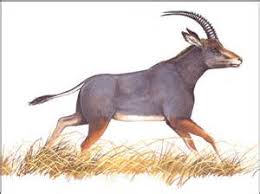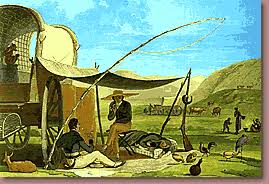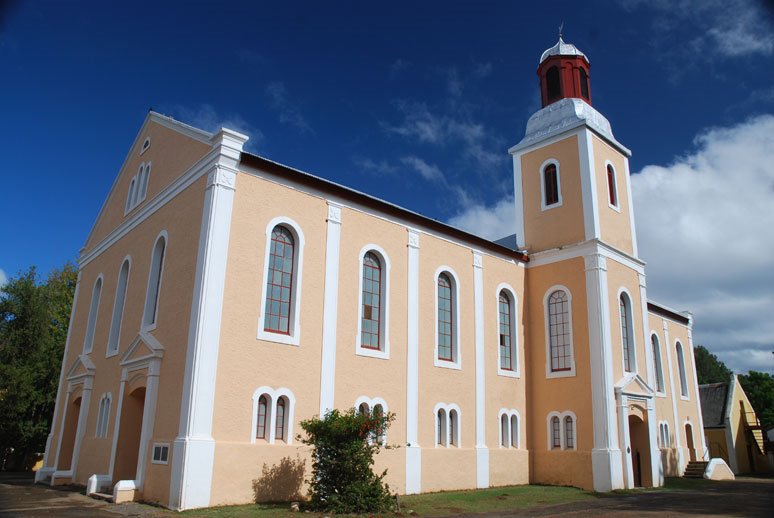Expanding European frontiers
The Trek Boers, with their servants and slaves, move inland
From the late 1600s and into the 1700s, the Cape settlers moved further north and east from Cape Town. This movement was led by the Trek Boers, who were looking for fresh grazing land for their cattle.
The Trek Boers preferred the freedom of their ox wagons and tents to living under the rule of the DElC. Their trek brought them into constant conflict with the local people.
First they met up with the Khoikhoi, who fought them off when the Boers tried to settle on Khoikhoi land. Later, in the East, they met up with the Xhosa, who also fought against the loss of their lands. Some of the Trek Boers owned slaves, and they took their slaves along with them. They also employed some Khoikhoi people as servants and they moved together, further into the interior of South Africa.
The Hottentots Holland Mountains can be seen as a natural boundary of the original Cape settlements. The Trek Boers moved beyond them and deep into the interior of what is now the Western Cape and beyond, into what are now the Eastern Cape and the Free State. As the map below shows, the various groups took widely different routes and spread all over the land beyond the original Dutch-controlled territory. Most of the land into which they moved is in the Karoo. This large region has soil that is not very fertile, and the area does not get much rain. From a farming point of view, the Karoo is much better suited to livestock (cattle and sheep) farming than to growing crops, which was ideal for the Trek Boers with their livestock.
 A blauwbok Image source
A blauwbok Image source
Conflicts happened as white settlement increased. In the 1730s, the Trek Boers and Khoikhoi clashed in the Piketberg district, not far from Cape Town. Local KhoiKhoi people raided the cattle farms in the area. The local farmers fought back and were helped by soldiers, and the KhoiKhoi were beaten.
The Trek Boers' way of life had some destructive effects. They hunted and killed wild animals, causing the extinction of the blauwbok and quagga populations. According to some reports, they captured and enslaved local women and children.
| Vocabulary | Definition |
|---|---|
| Isolated | far away from other places |
Lifestyles and stories of Trek Boers
The Trek Boers enjoyed living in small, isolated groups. When they made a rare trip to Cape Town, they usually felt uncomfortable. They liked the freedom and independence that came with living away from direct DEIC control. They saw the DEIC as oppressors who taxed them without giving much in return and who interfered with their hunting and trading with local tribes.
The Trek Boers were keen on hunting and enjoyed the freedom of moving around. They called this 'trek gees', meaning the 'spirit of moving'. They were tough adventurers, poorly educated but very religious. They called themselves 'Afrikanders' at first but were later known as the 'Afrikaners'. The Trek Boers spoke a language they called simply 'die taal' ('the language'). This was a very early version of Afrikaans, and was based mainly on Dutch, but also on French, German, Malay and Frisian (a language related to Dutch and German).
Land dispossession and consequences for the indigenous population
| Vocabulary | Definition |
|---|---|
| Dispossession | when someone takes away something that is yours |
Land dispossession has been South Africa’s story since its earliest days.
When the Trek Boers moved inland they began competing with the San, Khoikhoi and Xhosa for grazing land and water. Each group of people needed land to make a living, or even just to survive. There were many fights and raids between the groups during the 1600s. The Trek Boers had better weapons which resulted in hundreds of Khoikhoi being killed and dispossessed of their traditional grazing lands.
 Dispossessed of their traditional grazing lands Image source
Dispossessed of their traditional grazing lands Image source
Some Khoikhoi were forced to become labourers and servants for the Europeans. Others fled further inland to join the San on less fertile land in mountainous areas. Many Khoikhoi also died during three major outbreaks of smallpox and measles. Within 60 years of the Dutch landing at the Cape, the traditional economic, social and political order of the Khoikhoi had almost been destroyed.
Activity 1: Informal Assessment
Why did the Trek Boers often clash with the indigenous people? (2)
What advantage did the Trek Boers have over the Khoikhoi? (1)
What was the reason for the first French Huguenots coming to the Cape? (2)
Which mountains formed the natural boundary of the original Cape settlements? (1)
Why is the Karoo not a good region for growing crops? (2)
Which two animals became extinct due to the Trek Boers’ way of life? (2)
True or false: The Trek Boers enjoyed going to Cape Town occasionally. (2)
Name the 5 languages that the early version of Afrikaans was based on. (5)
Which two diseases caused many Khoikhoi to die? (2)
10. What was the meaning of ‘trek gees’ which the Trek Boers referred to? (1)
Total: 20
Genadendal: the first mission station in southern Africa 1738
Genadendal ('Valley of Grace') is a town in the Western Cape province of South Africa, built on the site of the oldest mission station in the country.
Georg Schmidt, an early worker of the Moravian Missionary Society, founded this mission station. There were 13 farms in the vicinity, and Schmidt taught the Khoikhoi people to read and write. Although he eventually had a small congregation, he was not an ordained minister. The Cape Dutch Reformed clergy were not happy when he baptised his converts. After seven years, he had to end his work and leave the country, in 1745.
The Moravians were only given permission again to carry on with Schmidt's work in 1792. At one stage, Genadendal was the largest settlement in the colony after Cape Town. A self-sufficient community came about. Home industries flourished, such as the forging of knives (still to be seen today).
Genadendal also became an important educational centre. The first Teachers' Training College in South Africa, now the museum building, was erected in 1838. This training college is now closed.
 Genadendal Church Image source
Genadendal Church Image source
The work of Lucy Lloyd and Wilhelm Bleek
Lucy Catherine Lloyd (7 November 1834 - 31 August 1914), along with Wilhelm Bleek, was the creator of the 19th century archive or historical collection of Ixam and !kun (Khoisan languages) texts.
She was born in England but moved to Durban when she was 14. (Her father became Archdeacon of the Anglican Church in Durban.) Her sister, Jemima, later married Wilhelm Bleek, in 1862. Bleek was a philologist (a person who studies languages in historical documents). He was put in charge of an archive (a collection of important historical documents), the Grey Collection, at the South African Library in Cape Town.
Their collection, started in 1870, consists of more than 13 000 documents (some just scraps of paper) that preserve the memory of the now 'lost' languages of Ixam and !kun.
Lucy Lloyd took charge of this collection after Bleek died. It was very unusual for a woman at that time to take this type of position. She was paid only half Bleek's salary. Their remarkable work has ensured that the heritage of the original inhabitants of the Cape has been kept forever.